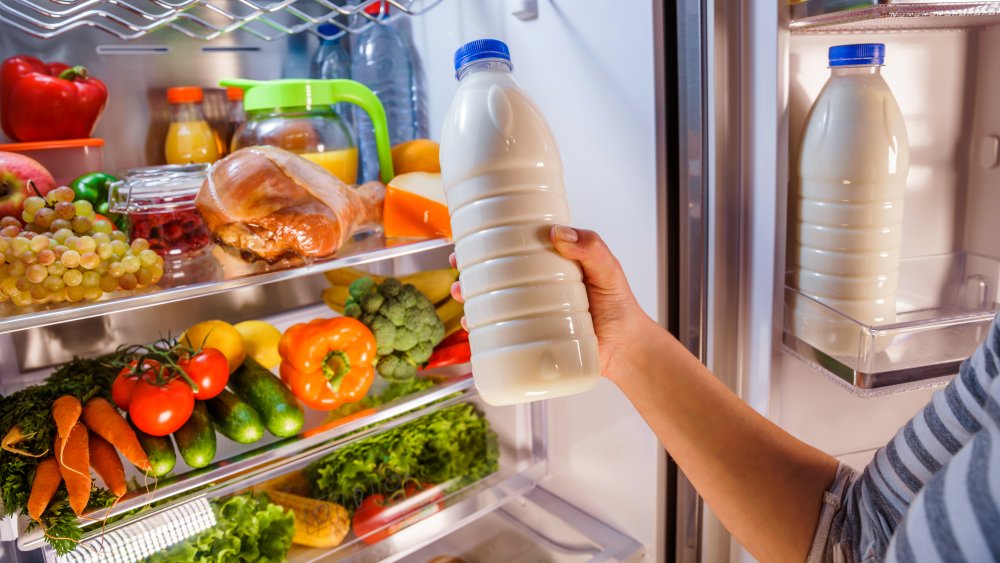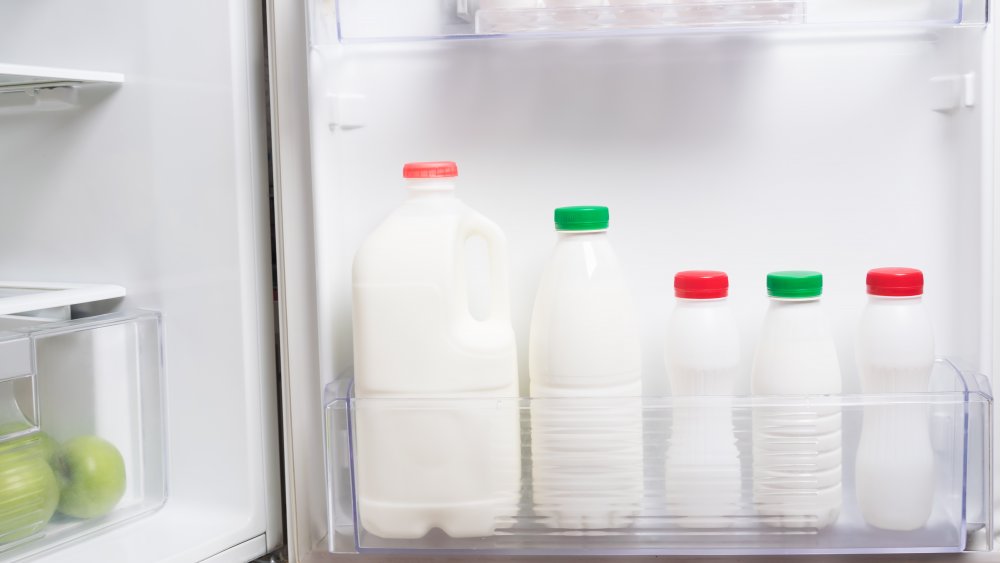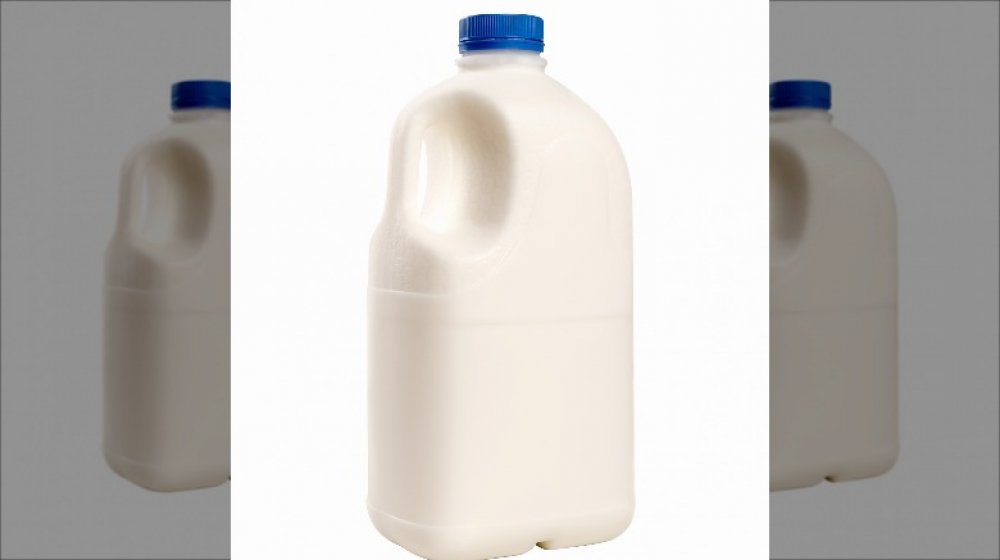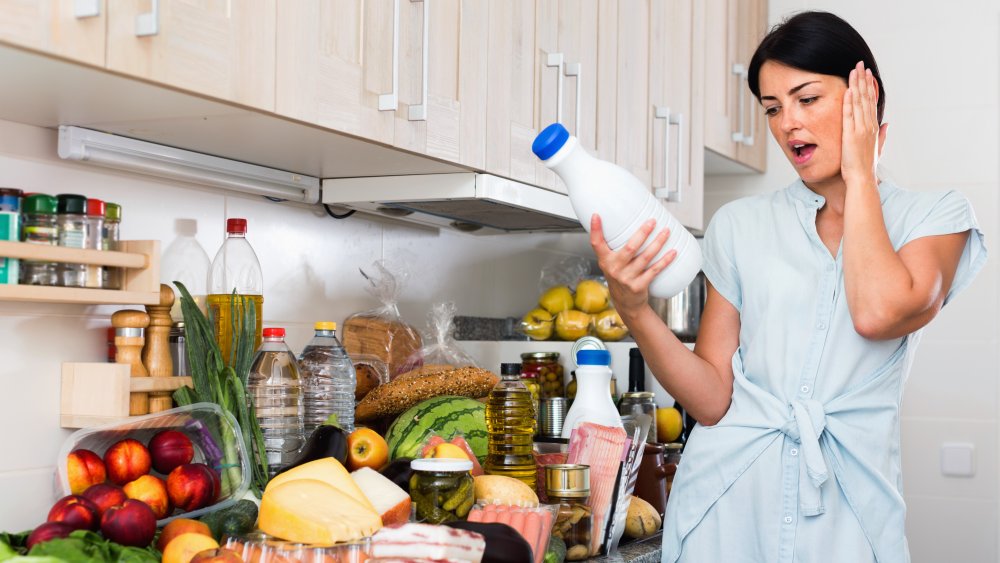You've Been Storing Milk Wrong Your Entire Life
Milk is one of those basic staple items people like to have on hand at all times. In fact, milk is something people typically stock up on before a snowstorm or other event that's likely to have them housebound. Along with bread and eggs, it forms one-third of what's sometimes referred to as the "holy trinity" of pre-disaster stocking up.
Once you've bought a few gallons of milk, though, you know it's not going to last indefinitely. While diamonds are forever (at least, according to James Bond movies), milk's freshness is a far more ephemeral commodity. According to dairy packaging supplier Stanpac, unopened whole milk will usually be good for five to seven days after the expiration date printed on the carton or jug, while 2% and skim milk will last for seven days. Nonfat and lactose-free milks last the longest, up to 10 days past the sell-by date.
Once they've been opened, all types of milk should be good for five to seven days — as long as you keep them refrigerated, that is. If you leave the milk out of the fridge for as little as two hours, it may start to spoil.
You shouldn't store milk in the fridge door
While the refrigerator door makes it easy to access some of our most-used items, it's also the one part of the fridge that is subject to the most temperature fluctuation. Once that door swings open, your milk goes from below 40 degrees Fahrenheit to room temperature, which doesn't do it much good. Any time the milk warms up, this gives bacteria an opportunity to grow, and this, in turn, hastens the process of spoilage.
"Dairy products, including milk, should be stored in the main compartment of the refrigerator, not in the door," Lynn Williams, Customer Support & Communications Program Specialist, Food Safety and Inspection Service at the USDA, tells Mashed. "The temperature of the storage bins on the door fluctuates more than the consistent temperature inside the cabin of the refrigerator and those perishable items are exposed to warm air each time the door is opened."
Real Simple suggests storing your milk on the back of a shelf in the lowest part of the fridge, as this tends to be the coldest area. Oh yeah, and shut the door as soon as you grab the milk, too. Your mom was right — standing there with the door open really does let all the cold air out, which won't benefit your milk or anything else in there.
You can freeze your milk, though
If you buy way more milk than you're likely to use before it goes bad, there's always the option of freezing it. To freeze milk successfully, though, there are a few things you'll need to be aware of.
The first thing is that milk, like any liquid, will expand when frozen, so if you plan to freeze it in its original container, you'll need to pour off a few inches before doing so. Reseal the container, making sure it's airtight, and then store it away from any other items that might transfer unwanted odors or flavors to the milk. Next to the ice cream should be ok, but right up against the frozen fish is not so good.
When it's time to take your milk out of the freezer, you should thaw it overnight in the refrigerator. Thawing anything at room temperature makes for a bacteria breeding ground, and because food-contaminating bacteria intend to make our lives difficult, we should return the favor rather than facilitating their little get-togethers on our kitchen counters. Your thawed milk may tend to be somewhat lumpy due to the fact that the fats have separated from the liquid, but a good shaking (or a whir in the blender) will help the milk regain its former texture. If it's still too weird for you to drink, you can always use formerly-frozen milk in cooking.
Slightly spoiled milk can still be put to good use
If your milk has gone really, really off to the point where it's actually rotten, you'll for sure know it. If the milk stinks like Satan's armpit as soon as you open it, or you unwisely take a swig and start gagging and spewing — right down the drain it goes. And if the milk has solidified to the point where the carton just goes "clunk" when you try to pour it ... well, that's just too gross to contemplate. At that point it's no longer milk, it's basically a science project.
If the milk is just starting to taste a little bit sour, though, you can use it for baking, no problem. Some recipes even call for sour milk; that slight sourness adds a little extra flavor. Chef Dan Barber of NYC's Michelin-starred restaurant Blue Hill, a well-known advocate of zero kitchen waste, told NPR that "cooking with sour milk is delicious" and suggested it as a substitute for buttermilk.
That means you can use your sour milk to make yummy biscuits, IHOP-style pancakes, tasty fried chicken, and even a new and improved version of boxed mac and cheese, and you won't have to feel guilty about letting perfectly good food go to waste.



